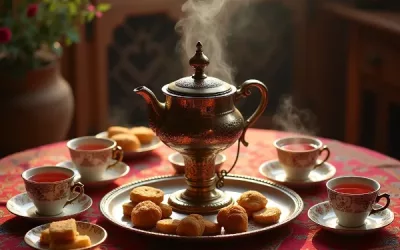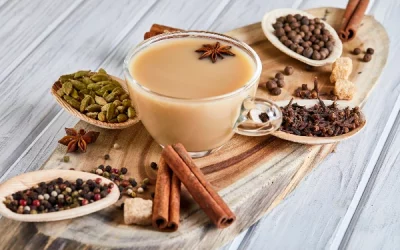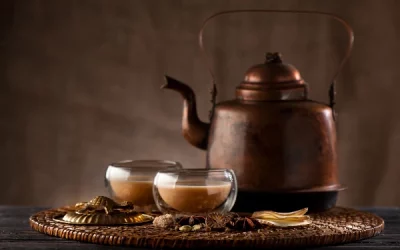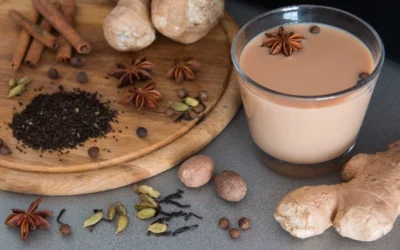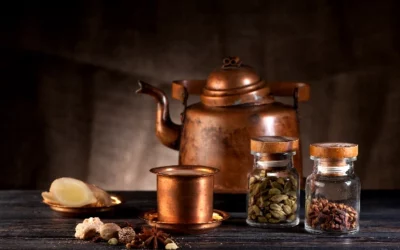Have you ever wondered whether your beloved masala chai contains caffeine? This question not only intrigues tea enthusiasts but also holds significant implications for health-conscious individuals and those sensitive to caffeine. Understanding the caffeine content of masala chai is essential, as it impacts your daily energy levels and overall wellbeing. This article will delve into the intricacies of masala chai’s caffeine levels, explore health implications, and discuss both caffeinated and caffeine-free options, offering you a comprehensive guide to enjoying this cultural beverage responsibly.
Table of Content
- What is the caffeine content in masala chai?
- How does the caffeine content in masala chai vary?
- What are the health implications of caffeine in masala chai?
- Are there caffeine-free alternatives to masala chai?
- How does masala chai fit into a balanced diet?
- What are the common misconceptions about caffeine in masala chai?
- How can one reduce caffeine in masala chai?
- What cultural significance does masala chai hold?
- Conclusion
What is the caffeine content in masala chai?
Masala chai, a popular spiced tea from India, has captivated tea lovers worldwide with its rich aroma and flavour. When it comes to caffeine content, masala chai contains caffeine, though the amount can vary. On average, an 8-ounce cup of masala chai holds about 30-50 milligrams of caffeine. This level is much lower than coffee, which has about 95 milligrams per 8-ounce serving, but slightly higher than green tea, which averages 20-45 milligrams per 8-ounce cup. Factors such as the type of tea leaves, brewing time, and preparation methods can influence the caffeine levels in masala chai.
Different types of tea leaves used, like black tea, contribute to the caffeine content. Black tea, commonly used in masala chai, naturally contains more caffeine. Additionally, brewing methods, such as steeping time and temperature, play a role. Longer steeping times and higher temperatures generally result in more caffeine extraction.
How does the caffeine content in masala chai compare to coffee?
Masala chai typically has less caffeine compared to coffee.
- An 8-ounce cup of masala chai has around 30-50 milligrams of caffeine.
- Coffee averages about 95 milligrams of caffeine per 8-ounce cup.
- Green tea, another popular beverage, contains about 20-45 milligrams per 8-ounce serving.
- Brewed masala chai can vary based on steeping methods and tea types used.
The lower caffeine content in masala chai makes it a suitable choice for those seeking a milder energy boost without the jittery feeling often associated with coffee. This characteristic also makes it a great evening beverage, allowing you to enjoy a warm, spiced drink without worrying about staying up too late.
What factors influence the caffeine levels in masala chai?
Several elements affect the amount of caffeine in masala chai. Understanding these factors can help you manage your intake according to your personal preference and sensitivity to caffeine.
- Type of tea leaves: Black tea has more caffeine than green or white tea.
- Steeping time: Longer steeping times increase caffeine extraction.
- Water temperature: Higher temperatures can draw out more caffeine.
- Serving size: Larger servings naturally contain more caffeine.
- Tea to water ratio: A higher concentration of tea leaves boosts caffeine content.
These variables allow for customisation of caffeine levels in your masala chai. For example, if you prefer less caffeine, consider using green tea leaves or reduce the steeping time. Conversely, for a bit more caffeine, choose black tea leaves and steep for a longer duration.
Can the caffeine content vary based on preparation methods?
The preparation methods of masala chai indeed impact its caffeine content. The technique you use can alter the final caffeine levels in your cup of chai.
- Boiling method: Boiling tea leaves in water tends to extract more caffeine.
- Steeping method: Steeping leaves in hot water gives moderate caffeine extraction.
- Cold brewing: Cold brewing extracts less caffeine over a longer time.
- Concentrated mixes: Pre-made chai mixes can have varying caffeine content depending on their formulation.
These methods allow for flexibility. If you’re looking to minimise caffeine, cold brewing might be an ideal choice as it offers a smoother taste with lower caffeine levels. For a traditional approach with moderate caffeine content, steeping or boiling remains popular.
In 19th century India, tea was primarily consumed by British colonists until Indian tea merchants began promoting it locally. They introduced masala chai to the masses by incorporating spices and reducing the amount of tea leaves to lower costs. This blend not only popularised tea consumption across India but also provided a caffeine boost lower than coffee, appealing to the local sensibilities.
How does the caffeine content in masala chai vary?
Masala chai, known for its delightful blend of spices and tea, does contain caffeine. But the exact amount of caffeine can vary greatly depending on several factors. These factors include the type of tea leaves used, how long you brew it, the ingredients you add in, and even the serving size. Let’s break it down.
Understanding the caffeine content in masala chai helps tailor your tea to your preferences and needs. Different factors can either ramp up or tone down the caffeine levels. Here’s a helpful table to guide you on how each factor might impact caffeine content:
| Factor | Caffeine Impact | Example |
|---|---|---|
| Type of Tea | High impact | Black tea has higher caffeine compared to green tea |
| Brewing Time | Moderate impact | Brewing for 4 minutes gives more caffeine than 2 mins |
| Ingredient Variations | Low impact | Adding milk can slightly dilute caffeine |
| Serving Size | High impact | A 12oz cup contains more caffeine than a 6oz cup |
| Tea Quantity | High impact | Using 2 teaspoons of tea leaves rather than 1 |
| Dilution | Low impact | Adding more water can reduce caffeine concentration |
| Spice Blend | Low impact | Cloves and cardamom don’t affect caffeine much |
Type of tea
The type of tea leaves you choose plays a significant role in determining the caffeine content of your masala chai. Black tea, known for its robust flavour, inherently possesses a higher caffeine level compared to its green or white tea counterparts.
- Black tea: Higher caffeine content
- Green tea: Moderate caffeine content
- White tea: Lowest caffeine content among the three
Opting for different teas can alter the caffeine profile of the chai without compromising on flavour.
Brewing time
How long you steep your tea also makes a difference. The longer the brewing time, the more caffeine gets extracted from the tea leaves.
- 1-2 minutes: Lower caffeine extraction
- 3-4 minutes: Moderate caffeine extraction
- 5+ minutes: Highest caffeine extraction
Brewing time significantly affects the strength and caffeine content of the tea. Adjust the duration to suit your caffeine sensitivity.
Ingredient variations
While the core spices in masala chai like cloves, cardamom, cinnamon, and ginger don’t affect caffeine levels, adding other ingredients can make a slight difference.
- Milk: Dilutes the caffeine slightly
- Water: More water means less concentrated caffeine
- Sugar/Honey: No impact on caffeine
The type and amount of additional ingredients can create a subtle change in caffeine content.
In the 17th century, masala chai gained popularity in India. Despite the British influence, who introduced tea as a national commodity, it was the addition of spices by Indian tea vendors that gave masala chai its unique, robust flavour. This mix distinguished it from the typical British tea, sealing its place not just as a drink, but as a cultural symbol.
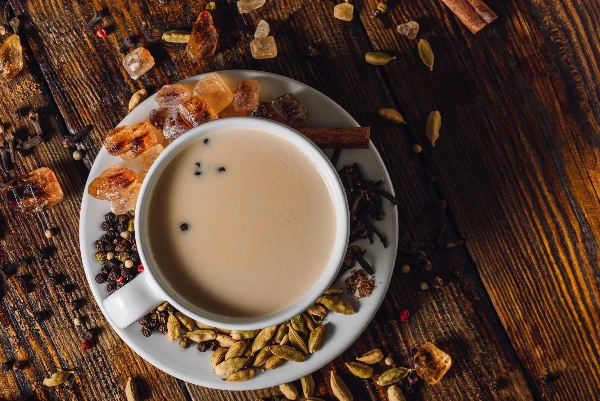
What are the health implications of caffeine in masala chai?
Alright, let’s address the steaming hot question on everyone’s mind: “does masala chai have caffeine?” Yes, it does. Now, before you spill your cup all over your trousers in shock, let’s chat about what this means for your health.
Masala chai, the spiced tea that’s a staple in many Indian households, brings together the earthy tones of black tea with a melange of aromatic spices. But amidst all that delightful flavour lies caffeine, the stimulant that can make or break your day—and sleep. We’ll unpack the health implications of this caffeinated delight, from how it messes with your Zzz’s to why moderation is the spice of life, all while sprinkling in some cultural context.
How can caffeine in masala chai affect sleep quality?
You know that scene where you’re wide awake at 3 a.m., staring at the ceiling? Blame caffeine.
- Caffeine can interfere with sleep, particularly if you drink masala chai too close to bedtime.
- The stimulant blocks adenosine receptors in your brain, which makes you feel less sleepy.
- It has a half-life of around 5 hours, meaning it takes that long for your body to eliminate just half of it.
- Even if you do manage to fall asleep, caffeine can affect the quality of your REM sleep—the part where you dream and rejuvenate your mind.
- If you’re caffeine-sensitive, even a small cup can lead to a night of tossing and turning.
So, if you have a nightly routine involving a soothing chai before bed, it’s time to consider switching to a caffeine-free alternative or at least making your last cup earlier in the day.
What are the benefits of moderate caffeine consumption?
Hold up, don’t throw the baby out with the bathwater. Caffeine isn’t all bad.
- In moderate amounts, caffeine can actually boost your mood, making you feel more alert and less groggy.
- It can enhance cognitive performance, improving concentration and memory.
- There’s evidence to suggest caffeine can aid in physical performance, giving you that extra pep in your morning jog.
- Antioxidants in black tea can support heart health and reduce inflammation.
- It may even help in warding off certain types of cancer, although the studies are still ongoing.
So, it’s all about balance. A cup or two of masala chai can be good for you, just don’t go chugging it like it’s water.
How does cultural perception influence caffeine consumption?
Ah, caffeine and culture—a match made in heaven or a recipe for disaster?
- In many cultures, like in India, tea is more of a social ritual than just a drink. People sip chai multiple times a day.
- In Western countries, coffee culture dominates, and people are more conscious of their caffeine intake.
- Some cultures view caffeine as a vital part of their daily life, akin to a comforting hug from your grandma.
- Others consider it a necessary evil, mainly due to its addictive nature and potential health downsides.
- And then there are those who embrace caffeine-free lifestyles, often due to the adverse effects on anxiety and sleep.
However, knowing the impact caffeine has on your body and sleep, it’s not too much of a leap to say that our views on caffeine need a bit of moderation, just like our consumption.
In the late 18th century, British East India Company soldiers stationed in India were introduced to masala chai by locals. Initially sceptical, they soon found the spicy beverage both invigorating and refreshing, especially during the sweltering Indian summers.
This marks one of the earliest cross-cultural encounters centred around masala chai, demonstrating just how intertwined our cultural perceptions and tea rituals can be.
Are there caffeine-free alternatives to masala chai?
Oh, the eternal struggle of wanting to enjoy the spicy, warming goodness of masala chai without buzzing around like a caffeinated bee. Fear not, there are splendid options out there for caffeine-conscious chai enthusiasts like you. From herbal alternatives to decaffeinated blends, let’s navigate this delightful world of caffeine-free masala chai.
Different herbal options and decaffeinated tea leaves
First, let’s chat about herbal chai options and all things decaf. Because yes, decaf tea leaves exist and they’re pretty darn marvellous.
Herbal Chai Options:
- Rooibos (Red Bush) Chai: A naturally caffeine-free wonder from South Africa with a slightly sweet and nutty profile, often blended with traditional chai spices.
- Honeybush Chai: Similar to rooibos but sweeter and very smooth. It’s a delightful base for those rich spices.
- Hibiscus Chai: Tart and vibrant, although unconventional, adding hibiscus gives your chai a unique and colourful twist.
- Spiced Apple Chai: A blend of dried apples and chai spices, this variant adds a fruity punch to your cup.
Decaffeinated Tea Leaves:
- Decaffeinated Black Tea Chai: Thank science for letting us keep the traditional black tea flavour without the caffeine jitters.
- Decaffeinated Green Tea Chai: Slightly lighter but still aromatic, if you fancy something a bit more subtle.
What are the best herbal alternatives to traditional masala chai?
Choosing the best herbal alternative to classic masala chai feels akin to picking your favourite pet – heart-wrenching but necessary. Depending on your taste buds and dietary preferences, there’s something for everyone.
- Rooibos Chai: Thick, sweet and nutty, it pairs perfectly with traditional masala spices like cardamom, cinnamon, and cloves.
- Chamomile Chai: Tranquil and soothing, though less robust, a chamomile base can be surprisingly delightful with chai spices.
- Tulsi (Holy Basil) Chai: This Ayurvedic herb brings a unique, slightly peppery flavour that complements the chai spices well.
- Peppermint Chai: Invigorating yet calm, it’s got a cool twist that sets it apart.
Your ideal herbal chai may vary depending on the specific flavour profile you crave. The good news? You have options and ample chances to experiment.
How does the flavour of decaffeinated chai compare to regular masala chai?
Now, let’s be real – the decaf world often gets a bad rap for being a bit, well, bland. But does it hold water (and flavour) when it comes to masala chai?
- Taste Profiles: Decaffeinated black tea chai retains most of the robust, full-bodied character of its caffeinated counterpart. It’s a bit like your favourite song performed acoustically – still hits all the right notes but with a gentler vibe.
- Intensity: Regular masala chai has a bolder punch, thanks to caffeine’s bitterness. Without it, decaf teas might taste slightly smoother.
- Depth: Green tea decaf versions are lighter and more nuanced, which some may prefer for a less overwhelming experience.
Overall, decaf versions do their best to mimic the original. While there’s a subtle difference in intensity, the signature spicy richness of masala chai remains intact.
Where can one find caffeine-free chai options?
Seeking out a caffeine-free chai is a bit like a treasure hunt. But the good news is, these treasures are quite findable!
- Speciality Tea Shops: Your local tea haven is a great place to start. They often carry an assortment of herbal teas and decaf options tailored to chai lovers.
- Online Retailers: Websites like Adagio Teas, Teavana, and Vahdam Teas offer a myriad of caffeine-free chai blends.
- Health Food Stores: Places like Whole Foods or Trader Joe’s partake in the herbal tea charm offensive quite fervently.
- Ethnic Grocery Stores: Indian or South African grocers frequently have unique herbal and spice blends that make for excellent chai bases.
Regardless of where you buy from, always check labels and ingredient lists to ensure you’re getting the authentic caffeine-free experience you’re after.
Back in the mid-1800s, when the British were having tea pity parties, an enterprising Scotsman named James Taylor planted tea in Sri Lanka. Fast forward a century and a half, and we are spoiled with choices like caffeine-free masala chai.
You see, if it wasn’t for these daring adventurers and their tea trials, you and I wouldn’t be here discussing rooibos and decaf alternatives. So next time you sip, maybe toast to those tea trailblazers!
How does masala chai fit into a balanced diet?
If you’re wondering where the beloved masala chai slots into a balanced diet, you’re in luck. This spiced tea has more to offer than just being an enjoyable beverage. It’s like the Swiss Army knife of the beverage world—a little bit of this, a little bit of that, all blending into a warm, spiced hug in a cup.
Let’s break down what masala chai does for you nutritionally, how to incorporate it into a healthy diet, and any potential bumps along the chai-latte road.
What are the nutritional benefits of masala chai?
Here’s the lowdown on why masala chai could be your next go-to health drink.
Exploring the Nutritional Benefits:
- Spices Galore: Masala chai is jam-packed with spices like ginger, cinnamon, cardamom, and cloves. These aren’t just flavour enhancers; they have anti-inflammatory and antioxidative properties that can give your immune system a bit of a leg up.
- Black Tea Base: The black tea in masala chai has a decent amount of antioxidants, notably polyphenols, which help fight off those pesky free radicals.
- Milk Factor: If you add milk (be it cow, almond, or soy), you’re looking at a good dose of calcium and protein. Your bones and muscles will thank you.
- Digestive Aid: The ginger comes into play here, easing digestion and potentially helping with nausea.
- Blood Sugar Regulation: Surprisingly, cinnamon can help in controlling blood sugar levels. So, you’re not just sipping; you’re stabilising.
Yet, it’s not just the nutrients that make it worthwhile. It’s how they come together to punch above their weight that makes masala chai a beneficial addition to your diet.
How can masala chai be incorporated into a healthy diet?
Now, incorporating masala chai into your day-to-day life without making it seem like an extra task is entirely possible. Think of it as a fun experiment rather than a dietary commitment.
Ways to Seamlessly Add Masala Chai to Your Diet:
- Morning Wake-Up Call: Swap your everyday coffee for a cup of masala chai. You get the caffeine kick without the jitters.
- Mid-Afternoon Slump: Instead of reaching for that sugary snack, a warm cup of chai can keep your energy levels steady.
- Paired with Breakfast: Masala chai goes great with oatmeal, toast, or even a fruit salad. It adds flavour without adding a ton of calories.
- Bedtime Inverse: Opt for a decaffeinated version in the evening. You still reap the benefits of the spices, sans the caffeine.
- Social Sips: Entertain guests with a pot of masala chai instead of sugary sodas or juices. It’s a win-win situation.
Nevertheless, the importance of moderation shouldn’t be overlooked. Practical portion control will keep you enjoying all the benefits without overdoing it.
Are there any drawbacks to regular consumption of masala chai?
Now, before you get too carried away, there are some potential drawbacks to be aware of. While masala chai is almost the Hermione Granger of beverages—smart, versatile, but occasionally overwhelming—it’s wise to consume it mindfully.
Potential Pitfalls of Regular Masala Chai Consumption:
- Caffeine Content: Despite its superpowers, black tea isn’t decaf. Too much can lead to insomnia or increased heart rate. Moderation is key.
- Added Sugars: Traditional recipes often include sugar. Be cautious with the sweet stuff or opt for healthier alternatives.
- Caloric Intake: If you’re adding milk and sugar, those calories can add up quickly. Watch your portions to avoid a calorie overload.
- Acid Reflux: Spices, particularly in large quantities, can trigger acid reflux for some folks.
- Milk Sensitivity: Lactose intolerant or sensitive to dairy? You might want to switch to plant-based milk options.
Every rose has its thorns, and masala chai is no exception. But a little thoughtful preparation can help you sidestep these potential drawbacks, ensuring every sip is savoured and beneficial.
Speaking of balance, did you know that Winston Churchill was a fan of tea, though his preferences were more leaning towards the black tea variety rather than spicy masala chai? During World War II, tea was a symbol of resilience and comfort for the British.
Lakshmibai, the Rani of Jhansi, famously served chai to her troops as a moral booster during the 1857 Indian Rebellion. She believed the spices and tea kept them alert and ready to face the British forces. Talk about a historic testament to the power of chai!
So whether for its rich nutritional benefits, the warmth of its spices, or its battle-ready spirit, masala chai deserves a spot in your balanced diet. Just enjoy it responsibly, like any fine potion.
What are the common misconceptions about caffeine in masala chai?
Who’s ever wondered whether masala chai can jolt you awake like a rocket or leave you snoozing like a lullaby? Well, you’re not alone. There’s a big mess of myths floating around about our beloved spiced tea and its caffeine content. Let’s unravel this caffeinated conundrum!
First off, not all caffeinated beverages are created equal. Comparing the caffeine levels in masala chai to coffee is like comparing a bulldog to a Chihuahua; they’re both dogs but of very different breeds. Many folks think masala chai packs the same punch as a cup of dark roast, but that’s far from reality.
The caffeine in masala chai primarily comes from black tea leaves, which have less caffeine than coffee beans. Additionally, the brewing process of chai dilutes it further, especially with all the milk and spices tossed in.
Another common belief is that drinking masala chai is detrimental to your health. Some proclaim that the combination of caffeine and spices is a disaster waiting to happen. Cue the eye roll! In reality, spices like ginger, cardamom, and cinnamon have numerous health benefits.
They aid digestion, boost immunity, and can even have anti-inflammatory effects. Hence, masala chai doesn’t just wake you up, it nurtures your insides too.
Transitioning smoothly into our deep dive into common myths, there are countless cultural stories and misguided opinions about this spiced delight. Let’s start dispelling these myths one by one.
What are some common myths about masala chai and caffeine?
People love to spread myths. They may be well-intentioned but nevertheless misleading. Here are the hot (get it?) myths about masala chai and caffeine:
- Masala chai has as much caffeine as coffee: Wrong! While masala chai does contain caffeine, it’s significantly less than your average cup of joe.
- Chai will wreak havoc on your heart: Oh, please. The spices in chai are actually very heart-friendly, fostering better circulation and reducing inflammation.
- Masala chai is a modern creation: Nope. This spiced tea dates back centuries in India, long before it became a hipster café staple.
- You can’t have masala chai before bed: Nonsense! The caffeine content is low enough that it won’t keep you awake unless you’re super sensitive to caffeine.
- Every masala chai is the same: The flavour and caffeine content can vary widely depending on the recipe and preparation method.
There’s a need for critical thinking between fact and fiction to shake off these myths.
How can one differentiate between fact and fiction regarding chai tea?
Separating fact from fiction isn’t rocket science; it’s more like brewing the perfect cup of tea. Here’s how you can tell what’s real and what’s exaggerated:
- Read labels and sources: Look at the caffeine content in different tea blends, and compare them with reliable sources.
- Consult experts: Tea experts and nutritionists can offer you well-grounded information.
- Test it yourself: Try different masala chai recipes and see how they affect you personally.
- Cultural research: Explore the historical context and traditional recipes for a broader understanding.
- Cross-check health studies: Look into scientific studies relating to the health benefits and risks of chai ingredients.
The fog lifts when you engage in a bit of due diligence. Now, let’s delve into why these misconceptions still roam free.
Why do misconceptions about chai persist in popular culture?
Misconceptions have a stubborn staying power in culture for several reasons. Here’s why masala chai myths are still swirling around:
- Misinformation: The spread of inaccurate information is like a bad cold; once it’s out there, it’s hard to eradicate.
- Marketing ploys: Some brands exaggerate caffeine content or health claims to sell more.
- Cultural myths: Misunderstandings of other cultures’ traditions and beverages contribute to myths.
- Generalisation: Lumping all caffeinated beverages into one category without appreciating their differences.
- Fear-mongering: Some people love to create hysteria around caffeine and health without substantial evidence.
Blame the internet, social media, or old wives’ tales, but these misconceptions have deep roots. Now, let’s swirl in a little history to spice things up further.
In the 1600s, tea became a sensation in Europe thanks to the Portuguese Princess Catherine of Braganza, who loved her daily cup. When she married King Charles II, tea culture burst into the British scene. Initially, tea was considered a luxury for the elite, but it gradually seeped into daily life, making it a staple.
Now, think about masala chai as a fusion of those early tea traditions blended with rich Indian spices. Isn’t it fascinating how cultural exchanges can brew something extraordinary over centuries?
So, the next time someone feeds you a masala chai myth, you’ll know how to stir the pot correctly! Cheers to tea and tradition!
How can one reduce caffeine in masala chai?
So, you’ve got a love affair with masala chai but can’t handle the caffeine jitters. I get it. This spiced beauty can pack a punch not just in flavour, but also in the wakefulness department. So, let’s break down some practical ways to tweak your masala chai recipe and still enjoy it without bouncing off the walls.
First things first, ditching some of the tea leaves is a good start. Yes, it might feel like sacrilege, but less tea means less caffeine. Alternatively, consider adding more herbal ingredients. Think ginger, cardamom, cinnamon—these bad boys contribute flavour without the caffeine crash.
Now, the brewing time is another crucial factor. Shortening the time your tea leaves lounge in the hot water reduces the caffeine content. Simple, right? Conversely, choosing decaffeinated tea leaves can be the knight in shining armour – they’re available if you look around.
Next, if you enjoy the creamy addition, experiment with different milk types. Some say almond or oat milk pairs splendidly with spices and may even dilute the overall caffeine concentration. Still with me? Cool.
What techniques can help reduce caffeine in masala chai?
Alright, time to dive into the nitty-gritty. Techniques to lower caffeine in your beloved chai come in various forms, and here’s a rundown:
- Use Fewer Tea Leaves: The simplest method. Reduce the amount of black tea you put in the mix.
- Opt for Herbal Ingredients: Add spices and herbs like ginger, cardamom, or cloves, which are caffeine-free but rich in flavour.
- Adjust Brewing Time: If steeping usually takes 5 minutes, cut it down to 2-3 minutes to lower caffeine extraction.
- Experiment with Milk Types: Dairy or plant-based milk can dilute caffeine. Almond or oat milk work well.
- Choose Decaffeinated Tea Leaves: Many brands offer decaf versions that maintain the taste without the kick.
Now, these aren’t magic tricks, but they work if you give them a try. The starting point is to balance between altering your recipe and keeping that signature taste. A dash of creativity goes a long way.
Are there specific tea brands that offer lower caffeine content?
You’re probably wondering, “Do brands even care about caffeine-sensitive folks like me?” Spoiler alert: They do.
Several brands have hopped on the low-caffeine wagon. Here are some that specifically cater to the mellow crowd:
- Tazo’s Decaf Chai: A well-known brand with a solid decaffeinated masala chai option.
- Twinings Decaf Chai Tea: Another big name offering the spiced delight without the caffeine burden.
- Yogi Tea’s Chai Rooibos: A caffeine-free blend using rooibos instead of black tea.
- Bigelow Decaf Spiced Chai: Trustworthy for their array of classic and decaf teas.
- Stash Tea Decaf Chai Spice: Known for putting the ‘flavour’ in your cup, minus the caffeine buzz.
These brands give you the ability to sip away without causing your heart to race. A quick trip to your local grocery or an online search should hook you up with one of these gems.
How does brewing time affect the caffeine levels in chai?
Alright, science time. How long you let your tea bathe in hot water plays a massive role in caffeine content. Here’s the lowdown:
- Shorter Steep Time: Less caffeine. Think of it as a quick dip.
- Longer Steep Time: More caffeine. It’s like making an espresso shot.
To get specific:
- Steeping for around 2-3 minutes results in a lighter chai with less caffeine.
- Letting it sit for, say, 5-7 minutes? You’re basically building a rocket fuel.
And here’s a pro-tip: start with a shorter brewing time and taste as you go. This way, you have control over both flavour and caffeine levels, rather than playing Russian roulette with your heart rate.
Back in the day, ancient Indian households made masala chai as a remedy. You bet they were careful about caffeine – they didn’t have energy drinks! Still, the ritual of boiling spices, tea leaves, and milk is deeply entrenched in the culture.
One tale tells of an Assam tea estate where workers would drink spiced tea mixed with jaggery to keep them energised but calm throughout the day. Just imagine them adjusting their brew times to get it just right.
You too can fine-tune your chai, following footsteps from history while sipping your perfect cup sans caffeine buzz.
What cultural significance does masala chai hold?
Masala chai isn’t just a drink; it’s a lifestyle. This brew, a harmonious blend of spices and black tea, represents more than just a beverage—it’s a symbol of hospitality, tradition, and an intrinsic part of daily life in many cultures. Let’s dive into its rich cultural importance.
Masala chai, or ‘spiced tea’, is embedded deeply in the tapestries of Indian culture, among other places. In India, chai is almost synonymous with welcome. You drop by a friend’s place? Chai is served. Striking a business deal? Chai is poured. It’s the social glue, the conversation starter, the ultimate gesture of warmth and hospitality.
How is masala chai traditionally prepared in different cultures?
You might think there’s a single recipe for masala chai, but oh, you’d be mistaken. This is a blend that’s as diverse as the people who make it.
- Indian Household: The classic masala chai is cooked up with black tea, milk, a medley of spices (think cardamom, cinnamon, ginger, cloves), and quite a decent amount of sugar. They don’t skimp on the flavours.
- Nepal: Here they often use more yoghurt than milk for a tangier touch. It’s specific, but it works wonders.
- Pakistan: They’ve got a bolder version, often heavier with black pepper and sometimes a hint of star anise.
- Western Adaptations: Over here, you might encounter the ‘chai latte,’ which is basically chai’s flamboyant, somewhat milk-washed cousin served with a side of gentrification.
- Regional Twists: In regions like Maharashtra, they love to add lemongrass, while up north in Punjab, they’ll often add a dollop of cream to make it rich.
The preparation involves boiling the chosen spices with water, letting the black tea leaves merrily steep, and then adding milk and sugar to taste. It’s almost like conducting a spicy symphony.
Masala chai is practically the lifeblood of social interactions. Picture this: you saunter into an Indian home. What’s the first thing someone offers you?
- Hospitality Symbol: Instant offer of masala chai or ‘chai’ implies ‘You’re welcome here.’
- Social Lubricant: Whether it’s a casual chat, important discussion, or neighbourhood gossip, chai acts as the humble facilitator.
- Family Time: For many, chai time means family time—a ritualistic gathering around the teapot to chat about everything and nothing.
- Break Time: Office scenario? The ‘chai break’ is almost sacred—colleagues bond over sips of the hot brew.
- Street Corners: Ever heard of ‘chaiwallahs’? These tea-vendors are at every corner, creating makeshift spaces for people from all walks of life to converge and converse.
Masala chai’s role goes beyond the taste—it’s about the connections, the stories shared over a steaming cup, the bonds strengthened sip by sip.
How has masala chai evolved in contemporary society?
Now, while we still uphold grandmama’s recipe, masala chai has taken on a bit of a modern twist.
- Global Spread: It’s no longer confined to South Asia. Thanks to the diaspora, chai can be found in cafes from New York City to London.
- Chai Lattes: This fusion version caters to Western aesthetics—lighter, fluffier, and often drowned in frothy milk.
- Health Fads: Many folks now opt for ‘organic’ or ‘vegan’ versions. Don’t get me started on the ‘chai detox’ trends!
- Ready-to-Drink: Walk into a grocery store, and you’ll find instant chai mixes, bottled versions, and even chai-flavoured snacks.
- Culinary Experiments: Chefs are getting creative, integrating chai spices into desserts, baked goods, and even savoury dishes.
While evolving, masala chai remains loyal to its roots, continuing to be a staple in modern households, tea shops, and cafes worldwide.
During the Second World War, the British, who were enamoured with their afternoon tea, found themselves in India. Guess what they discovered? The local version of their beloved beverage—but with a kick! They were initially taken aback by the spices but soon found themselves smitten. Those British officers returned home with new palates. That’s right—masala chai crossed oceans not just by migration but on the coattails of colonial expeditions.
So next time you sip on your spicy, comforting cup of masala chai, remember: it’s more than a drink. It’s a bridge between cultures, a historical relic, and a symbol of hospitality. Cheers!
Conclusion
In wrapping up our exploration of masala chai and its caffeine content, I’ve come to appreciate the complexity and richness of this beloved beverage. We’ve examined how masala chai typically contains less caffeine than coffee while potentially rivaling green tea, largely influenced by brewing methods, types of tea leaves, and serving sizes.
The caffeine levels can indeed vary, affected by multiple factors such as tea type and ingredient variations, as highlighted in the detailed table we provided. Understanding these nuances is essential, particularly for those who may be sensitive to caffeine or for whom its consumption could affect their sleep and mental wellbeing.
The cultural significance of masala chai—its role in traditions, social gatherings, and culinary practices—adds another layer to its importance, inviting us to consider not just what we drink, but why we drink it. Additionally, as more people seek caffeine-free options, it’s heartening to know there are rich herbal alternatives available that still honour the traditional flavours.
Looking ahead, exploring how masala chai fits within a balanced diet opens doors to further investigations—what combinations of ingredients can enhance its health benefits while minimising potential drawbacks? Can we continue to adapt our beloved recipes without losing their essence?
The journey of masala chai, both personally and culturally, invites reflection. As we enjoy our cups, let’s ponder: what does this simple blend of spices, tea, and milk represent in our lives and communities? To paraphrase the saying, “A cup of tea is a cup of peace.” Each sip of masala chai can indeed be a moment of connection, not only with our surroundings but also with the rich tapestry of tradition from which it comes.
Resources
- Coffee, caffeine, and sleep: A systematic review of epidemiological studies
- Adenosine, caffeine, and sleep-wake regulation: state of the science
- The impact of daily caffeine intake on nighttime sleep in young adult men
- The Impact of Caffeine and Coffee on Human Health
- The Effect of Brewing Process Parameters on Antioxidant Activity and Caffeine Content
- The impact of caffeine on sleep and sleep disorders


